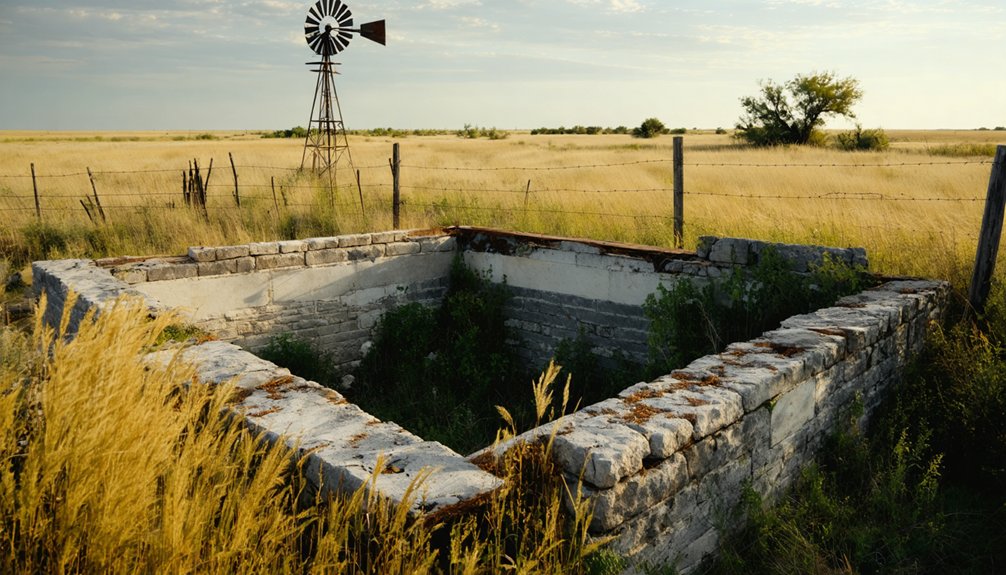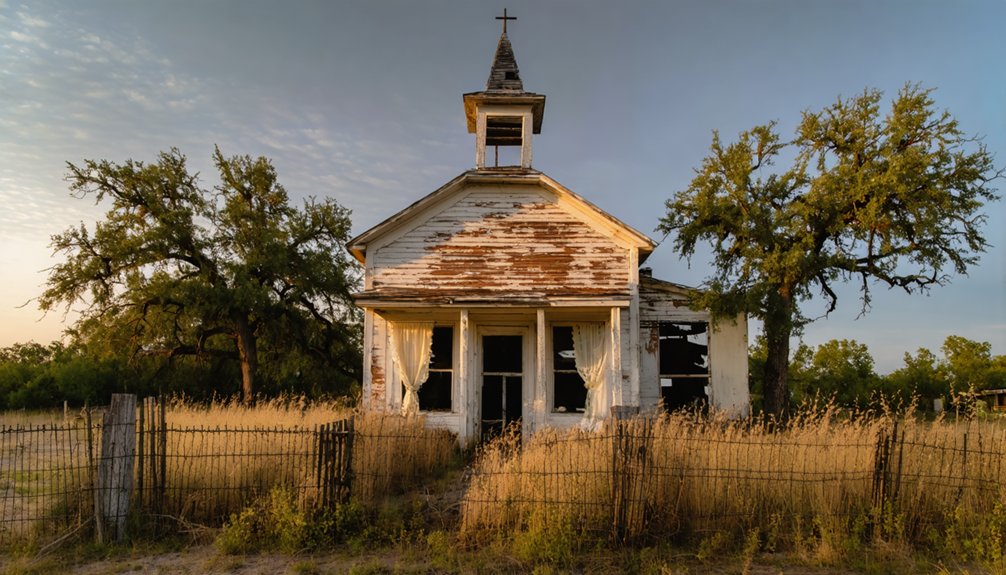You’ll discover the ghost town of Mendota nestled along Red Deer Creek in Moore County, Texas, where a once-thriving railroad trading post established in 1887 now stands abandoned in the Texas Panhandle. The town flourished after relocating to the Panhandle & Santa Fe Railway line in 1907, supporting about 100 residents through farming and commerce. Today, weathered ruins, adobe structures, and hidden rail tracks tell the story of this forgotten plains community’s rise and fall.
Key Takeaways
- Mendota was established in 1887 near Red Deer Creek and relocated in 1907 to the Panhandle & Santa Fe Railway line.
- The town thrived as a railroad trade hub with about 100 residents engaged in farming, ranching, and commerce.
- Historical buildings included adobe structures, wood-frame houses with tin roofs, and industrial remnants from its mining era.
- Decline began after the 1940s when railroad service decreased, leading to economic downturn and population exodus.
- Today, weathered ruins, mining equipment, and hidden rail tracks remain, requiring permission and safety precautions for exploration.
Origins and Early Settlement
While many Texas Panhandle settlements emerged organically, Mendota’s establishment in 1887 came through deliberate planning by St. Louis developers who platted the town along Red Deer Creek.
Like Thurber’s experience with labor recruitment, the town drew settlers from diverse backgrounds seeking new opportunities in Texas.
You’ll find settler motivations were deeply rooted in the promise of agricultural prospects, with many Midwesterners drawn to the region’s fertile soil and water access.
The town’s name, borrowed from Mendota, Illinois, reflected the strong influence of these Midwestern pioneers.
Like many frontier towns, Mendota carried its Midwestern heritage in its name, echoing its Illinois namesake.
You can trace how these early settlers, primarily farmers and ranchers, built their homesteads near the creek, establishing basic community structures.
The small community grew to support several key establishments including a post office and store, serving the needs of approximately 100 residents during its peak years.
The Railroad’s Transformative Impact
Because Mendota’s survival hinged on railroad access, the town’s 1907 relocation to the Panhandle & Santa Fe Railway line marked a pivotal transformation.
Similar to the 1888 Union Depot in Illinois, the transport hub became central to the town’s identity.
You’d have witnessed the railroad evolution reshape this Texas settlement into a bustling trade hub, where steam engines brought unprecedented economic significance through freight and passenger services.
The transport technology revolutionized local commerce, allowing ranchers and farmers to ship cattle and crops to distant markets.
Rail connectivity spawned new businesses – warehouses, supply stores, and repair shops emerged to support the expanding rail operations.
You could’ve seen how the railroad’s presence attracted settlers and investors, fostering growth throughout Mendota’s peak years.
The town’s fortunes were so intertwined with the rails that when service declined post-1940s, it triggered Mendota’s gradual descent toward ghost town status.
Like many rail towns, Mendota saw its last passenger services end as steam engines retired in 1951, marking the beginning of its eventual decline.
Life in Mendota’s Golden Era
Life in Mendota during its peak years painted a portrait of frontier resilience and community spirit. You’d find about 100 residents living in modest wood-frame houses, working together to build a thriving settlement along the railroad route.
Daily routines revolved around farming, ranching, and trading, with families spending long hours tending to livestock and crops. Local farmers often conducted their major transactions at the grain marketplace facilities.
Community events brought everyone together, centered around trading activities and religious gatherings. You’d see neighbors helping neighbors, sharing stories during evening socials, and celebrating seasonal harvests. Like the residents of Toyah ghost town, the population gradually declined as economic opportunities diminished.
While the town’s infrastructure remained basic, with simple roads and essential stores, the railroad connection provided crucial access to supplies and communication.
Life wasn’t easy – you’d need to be self-sufficient and hardworking – but the close-knit community made frontier living manageable.
Economic Activities and Trade
You’ll find Mendota’s economic heart centered around its strategic position as a railroad trade hub, where local farmers and ranchers shipped their grain and cattle to broader markets.
The town’s merchants and traders acted as crucial intermediaries, providing essential agricultural supplies while facilitating the exchange of wheat, cereals, and livestock. When local industries declined, the town experienced rapid abandonment as residents sought opportunities elsewhere.
Though smaller than neighboring Canadian, Texas, Mendota’s rail access and trading facilities helped sustain local commerce through the seasonal rhythms of planting, harvesting, and cattle drives. Like many of the 511 ghost towns across Texas, Mendota’s prosperity was closely tied to its transportation connections and regional trade networks.
Railroad Trade Hub
When railroads converged at Mendota in 1853, they transformed this Texas settlement into a bustling trade hub that would handle up to 40 trains daily at its peak. The railroad expansion brought major carriers like Illinois Central, CB&Q, and Milwaukee Road, establishing essential trade routes throughout the region. The community arose specifically because two railroads met at this strategic crossing point.
You’d find a grand railroad station built in the late 1800s, complete with passenger waiting rooms and cargo handling facilities. The freight logistics operation included a bustling railroad yard where crews assembled and disassembled trains. Transport costs dropped significantly compared to wagon travel, which had previously cost twenty cents per ton mile.
During World War II, about 75 railroad employees kept the hub running smoothly, moving agricultural products and manufactured goods to distant markets. The constant sound of steam locomotive whistles and thundering engines became the heartbeat of this thriving Texas trade center.
Agricultural Supply Center
The heart of Mendota’s economic activity centered on its thriving agricultural supply operations, where local merchants and cooperatives stocked essential farming supplies for the region’s producers.
You’d find everything from seeds and fertilizers to machinery and animal feed, creating a robust supply chain that served surrounding farms.
The cooperative benefits were significant, as farmers joined forces to improve their purchasing power and secure better prices on equipment and supplies.
These organizations also provided critical marketing channels for cotton and grain crops.
While fires and economic challenges periodically disrupted operations, Mendota’s agricultural supply center adapted by offering machine repair services and modernizing its facilities.
Local milling and processing operations, including cotton gins and flour mills, further strengthened the town’s position as an indispensable agricultural hub.
Notable Buildings and Landmarks

Standing as silent witnesses to Mendota’s silver mining era, numerous adobe structures and industrial remnants dot the Texas ghost town’s landscape.
You’ll find long, single-story residential architecture featuring tin roofs and distinctive cupolas, while scattered mining relics tell the story of Texas’s only silver mining venture. The 1936 monument and Brooks Memorial serve as central landmarks, helping you navigate the town’s historical significance.
Throughout the site, you’ll discover rusted machinery and mining equipment that once powered the town’s economic engine.
The remains of communal buildings and bunkhouses reveal the collective spirit of the mining community, while partial adobe walls and limestone structures showcase the architectural preferences of the era.
Many buildings, though decaying, still display their original construction features and subsequent adaptations.
The Path to Abandonment
Mendota’s path from bustling rail town to abandoned settlement began in 1887 along Red Deer Creek, where early settlers established a promising trading hub.
You’ll find the primary abandonment reasons centered on the town’s heavy dependence on railroad commerce, which proved fatal when transportation patterns shifted and rail service declined.
Economic shifts hit Mendota particularly hard as nearby towns with better infrastructure drew away business and residents.
The lack of major highways or modern road networks isolated the community further. You can trace the exodus of younger generations to urban areas, leaving behind empty buildings and dwindling services.
The harsh plains environment and distance from major cities compounded these challenges, while agricultural uncertainties made it difficult for remaining residents to sustain themselves without reliable rail connections.
What Remains Today

Weathered ruins scattered across Mendota’s former townsite offer glimpses into its once-thriving past.
Today’s ruins exploration reveals partially collapsed buildings, buried foundations, and remnants of domestic life like cobalt-blue tiles and concrete bathtubs. You’ll find nature’s relentless impact as sand and vegetation slowly consume what’s left of this Texas ghost town.
- German-influenced architectural details peek through crumbling walls adorned with fading wallpaper and paint.
- Old rail tracks lie hidden beneath sand, with only brief stretches still visible to curious explorers.
- Interior features like fireplaces and built-in bookcases stand as silent witnesses to middle-class life.
The environmental impact is clear – sun, wind, and rain continue their steady assault on these unprotected structures, while minimal preservation efforts mean these fragments of history slowly fade away.
Tips for Ghost Town Explorers
Before venturing into Mendota’s historic ruins, you’ll need to prepare thoroughly for both safety and legal compliance. While ghost stories might draw you to this fascinating site, exploration ethics must guide your visit. Always secure permission from landowners first, and never explore alone.
Pack essential safety gear including flashlights, respirators, first aid supplies, and offline navigation tools. You’ll want to dress appropriately and carry communication devices for emergencies.
Watch for structural hazards, wildlife, and dangerous materials like asbestos. When exploring buildings, move carefully and avoid disturbing artifacts or creating new paths.
Historical Legacy and Preservation

When you explore Mendota’s remaining foundations and building sites today, you’ll find evidence of the town’s late 19th-century origins through scattered artifacts and structural remnants.
Historic maps reveal five key locations where metal detecting and archaeological surveys could uncover items from the settlement’s railroad trading period.
Your discoveries at these sites contribute valuable data for documenting Texas Panhandle history, as few formal preservation efforts exist for this ghost town.
Archaeological Potential Today
As a preserved ghost town with restricted access and protective fencing, Mendota’s archaeological landscape offers significant research potential through its mining equipment, building foundations, and partially intact structures.
You’ll find rich opportunities for archaeological techniques and artifact recovery across the site, where minimal modern disturbance has helped preserve subsurface materials.
Historic maps guide exploration of this silver mining settlement, established in 1887.
- Metal detecting and archaeological hiking can reveal mining tools, household items, and industrial remnants
- Layered settlement evidence enables detailed stratigraphic studies of different occupation periods
- Natural springs and original tree growth provide environmental context for understanding the town’s development
Remember to respect private property rights and preservation mandates while investigating these valuable historical resources that document Texas frontier life.
Past Meets Present
Today’s Mendota stands as a compelling tribute to Texas railroad history, where crumbling foundations and weathered structures tell the story of a once-thriving frontier town.
You’ll find local historians and enthusiasts working to preserve community stories through digital archives and field exploration, ensuring this chapter of Texas heritage isn’t lost to time.
While few original structures remain standing, historical artifacts continue to surface through the dedicated work of amateur researchers and metal detectorists.
The town’s evolution from its 1887 founding along Red Deer Creek to its railroad-driven relocation mirrors countless other Western settlements.
Despite preservation challenges and limited resources, Mendota’s legacy endures through local historical societies, tours, and educational initiatives that connect modern visitors with this fascinating piece of railroad-era Texas.
Frequently Asked Questions
Were There Any Notable Crimes or Lawlessness Incidents in Mendota’s History?
Like a gentle breeze leaving no trace, you won’t find any documented crime sprees or significant law enforcement activity in Mendota’s history – records show it remained remarkably peaceful until its economic decline.
What Native American Tribes Originally Inhabited the Area Before Mendota’s Establishment?
You’ll find rich cultural heritage from the Tonkawa, who originally controlled this territory, with Comanche and Apache tribes later moving through the area, bringing their distinct tribal traditions and nomadic lifestyles.
Did Any Famous Historical Figures Ever Pass Through or Stay in Mendota?
You won’t find records of any famous visitors or significant historical events in Mendota’s past. The town’s brief role as a trading post didn’t attract notable historical figures.
What Was the Average Property Value of Homes During Mendota’s Peak?
You’re looking at a modest property market where homes likely valued between $300-$1,000 during peak years. Housing trends followed typical small railroad town patterns, though exact records don’t exist.
Were There Any Documented Natural Disasters That Impacted the Town?
You won’t find documented natural disasters specific to the town’s history. While the region experienced typical Panhandle natural phenomena like storms and droughts, no disaster recovery efforts were explicitly recorded for this location.
References
- https://www.tshaonline.org/handbook/entries/mendota-tx
- https://www.jasonrweingart.com/blog/2016/10/4/ten-most-terrifying-abandoned-places-in-texas
- https://www.lonestartreasure.com/texas-ghost-towns-and-their-buried-riches/
- https://en.wikipedia.org/wiki/List_of_ghost_towns_in_Texas
- https://pastmaps.com/explore/us/texas/hemphill-county/mendota/metal-detecting
- https://pastmaps.com/explore/us/texas/hemphill-county/mendota/hiking-exploration
- https://www.texasescapes.com/TexasPanhandleTowns/Mendota-Texas.htm
- https://www.texasescapes.com/TOWNS/Texas_ghost_towns.htm
- https://discovertexasoutdoors.com/places/mendota-texas-a-ghost-town-born-from-the-railroad-era/
- https://www.youtube.com/watch?v=phjUE19A8HM



